And so we arrive in the television era again. As usual, Hanna Barbera takes the lead in producing beach-related episodes, while a handful of surviving theatrical studios provide occasional output on similar themes, either in the guise of big or small screen productions. Now, it is possible for the audience to enjoy the aesthetics of fresh air and sunshine, without even venturing out of doors, from the shady confort of one’s living room – and with no risk of leaving sun tan oil stains on the sofa cushions.

CHRONOLOGICAL NOTE: For this week’s article, I’ll be skipping over a couple of Popeye episodes and some Magoo material for which exact release dates are unknown. We’ll handle them as a group next time. I will also be skipping “Beany and Ceceil”, which has the Leakin’ Lena landing on a new shore practically every week, simply for the purposes of brevity.
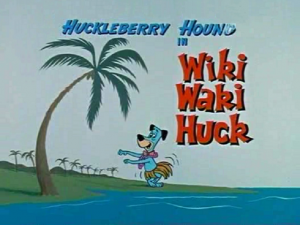 Wiki Waki Huck (Hanna/Barbera, Huckleberry Hound, 2/15/60) – In Hawaii, island boy Huckleberry Hound (the first Hawaiian native ever to speak with a Southern accent) teaches the audience the native customs of his islands. First, their favorite sport, surfing. It takes Hawaiian know-how to catch a wave just right and keep your balance at 40 miles per hour – er, that is, 50…60…70…HELP!!! Huck hits the sand, boring a path right through the dunes, and crashing nose first into a tree trunk. Next, he demonstrates sword dancing (in the technique of Fox anf Crow discussed in an earlier installment). After the demonstration, Huvk states that it’s a lot of fun – especially if you belong to some hospital plan or another (returning to his hut in casts and bandages. But the favorite Hawaiian tradition is the luau, complete with a nice tender young pig. Huck prepares the still quite alive pih by rubbing butter all over him, which he describes as sort of a sun-tan lotion to ensure that the pig will be evenly brown all over when roasted over coals. When the pig hears this, he quickly decides a hasty exit is appropriate. Huck tries to tackle him, but is quickly reminded that there’s nothing slipperier than a greased pig, and only succeeds in crashing into another tree.
Wiki Waki Huck (Hanna/Barbera, Huckleberry Hound, 2/15/60) – In Hawaii, island boy Huckleberry Hound (the first Hawaiian native ever to speak with a Southern accent) teaches the audience the native customs of his islands. First, their favorite sport, surfing. It takes Hawaiian know-how to catch a wave just right and keep your balance at 40 miles per hour – er, that is, 50…60…70…HELP!!! Huck hits the sand, boring a path right through the dunes, and crashing nose first into a tree trunk. Next, he demonstrates sword dancing (in the technique of Fox anf Crow discussed in an earlier installment). After the demonstration, Huvk states that it’s a lot of fun – especially if you belong to some hospital plan or another (returning to his hut in casts and bandages. But the favorite Hawaiian tradition is the luau, complete with a nice tender young pig. Huck prepares the still quite alive pih by rubbing butter all over him, which he describes as sort of a sun-tan lotion to ensure that the pig will be evenly brown all over when roasted over coals. When the pig hears this, he quickly decides a hasty exit is appropriate. Huck tries to tackle him, but is quickly reminded that there’s nothing slipperier than a greased pig, and only succeeds in crashing into another tree.
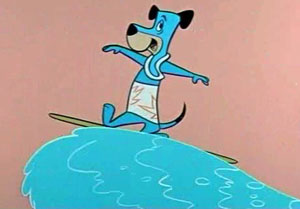 The hound begins laying a series of traps for the pig, baited by apples, The first is supposed to cause the pig to bite through a rope, snapping it and dropping a metal pail over the pig. Instead, the pig darts through on the fly, and the pail plops down over Huckleberry. Next, an apple tied to a tree from a string, suspended higher than the pig can jump, designed to tire him out. The witty pig avoids this consequence too, by climbing vertically down the string from the tree fronds above, devouring the apple. Then, an apple placed on the ground next to a tree trunk, with a surfboard also strapped on one end to the tree trunk from behind. Huck bends the surfboard backwards like a springboard, intending to release it to whap the pig in the face when he appears for the apple. The pig again is too fast for Huck, and when Huck releases the board, it only flips around the tree and whacks Huck in the back, for another crash into yet another palm. Fourth, an apple placed at the end of a hollow log, with Huck waiting on the same end to catch the pug in a catcher’s mitt. Like a bullet, the pug shoots through, not only making a gaping hole in the mitt, but in Huck’s abdomen as well. Finally, an apple in a snare trap. But Huck’s “oinks” to attract the pig instead draw the attention of a wild boar. Huck’s snare grabs the boar by the snout, and when Huck drags him in, for a meeting nose to nose, all Huck can say is “I kinda remember that pig being a mite smaller.” The chase is on, with Huck the pursued. But Huck has learned from the pig’s tricks, and grabs the stick of butter to slick himself up, making his own body too slippery to hold onto. The chase goes on, for a presumably indefinite run, with Huck slipping out of the boar’s grasp again and again.
The hound begins laying a series of traps for the pig, baited by apples, The first is supposed to cause the pig to bite through a rope, snapping it and dropping a metal pail over the pig. Instead, the pig darts through on the fly, and the pail plops down over Huckleberry. Next, an apple tied to a tree from a string, suspended higher than the pig can jump, designed to tire him out. The witty pig avoids this consequence too, by climbing vertically down the string from the tree fronds above, devouring the apple. Then, an apple placed on the ground next to a tree trunk, with a surfboard also strapped on one end to the tree trunk from behind. Huck bends the surfboard backwards like a springboard, intending to release it to whap the pig in the face when he appears for the apple. The pig again is too fast for Huck, and when Huck releases the board, it only flips around the tree and whacks Huck in the back, for another crash into yet another palm. Fourth, an apple placed at the end of a hollow log, with Huck waiting on the same end to catch the pug in a catcher’s mitt. Like a bullet, the pug shoots through, not only making a gaping hole in the mitt, but in Huck’s abdomen as well. Finally, an apple in a snare trap. But Huck’s “oinks” to attract the pig instead draw the attention of a wild boar. Huck’s snare grabs the boar by the snout, and when Huck drags him in, for a meeting nose to nose, all Huck can say is “I kinda remember that pig being a mite smaller.” The chase is on, with Huck the pursued. But Huck has learned from the pig’s tricks, and grabs the stick of butter to slick himself up, making his own body too slippery to hold onto. The chase goes on, for a presumably indefinite run, with Huck slipping out of the boar’s grasp again and again.
Here’s an excerpt:

The rarely seen original titles for the Jeepers and Creepers series
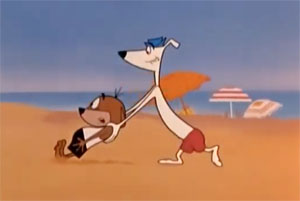 Jeepers is preparing for a night of romance, with a vanity mirror on his dresser set up as a spinning wheel of fortune, studded with pictures of pretty girls to choose fom for the evening’s action. Creepers, however, on;y has an old photo album to muse over, still carrying the torch for one he admired 20 years ago, as a child in mere “puppy love”. However, he does have one modern-day photo from a newspaper clipping to show how she turned out – an article displaying the shapely Cuddles Rodgers, beauty contest winner. Jeepers is determined to bring these two together, but Creepers admits he hasn’t seen her for 20 tears, and doesn’t even know where she lives. Jeepers suggests visiting every Rodgers in the phone book until they find her. With floral bouquet in hand, Creepers is pushed hesitantly toward the first door on their list by Jeepers. The bell is answered by a total stranger, who is a man-hungry “dog” with the aggressiveness of the Simple Siren we encountered in an earlier installment of this article series. She drags Creepers into her apartment, and Jeepers watches through the keyhole as a mad chase goes on inside. Creepers tries to escape in the dumbwaiter, but the amorous female gets him in her grip. The only thing that breaks up the kiss is Jeepers applying the nozzle of a vacuum cleaner to the keyhole slot in the front door, sucking the manchaser back across the room to stick by her rear end to the door, satisfied that she at least got one kiss.
Jeepers is preparing for a night of romance, with a vanity mirror on his dresser set up as a spinning wheel of fortune, studded with pictures of pretty girls to choose fom for the evening’s action. Creepers, however, on;y has an old photo album to muse over, still carrying the torch for one he admired 20 years ago, as a child in mere “puppy love”. However, he does have one modern-day photo from a newspaper clipping to show how she turned out – an article displaying the shapely Cuddles Rodgers, beauty contest winner. Jeepers is determined to bring these two together, but Creepers admits he hasn’t seen her for 20 tears, and doesn’t even know where she lives. Jeepers suggests visiting every Rodgers in the phone book until they find her. With floral bouquet in hand, Creepers is pushed hesitantly toward the first door on their list by Jeepers. The bell is answered by a total stranger, who is a man-hungry “dog” with the aggressiveness of the Simple Siren we encountered in an earlier installment of this article series. She drags Creepers into her apartment, and Jeepers watches through the keyhole as a mad chase goes on inside. Creepers tries to escape in the dumbwaiter, but the amorous female gets him in her grip. The only thing that breaks up the kiss is Jeepers applying the nozzle of a vacuum cleaner to the keyhole slot in the front door, sucking the manchaser back across the room to stick by her rear end to the door, satisfied that she at least got one kiss.
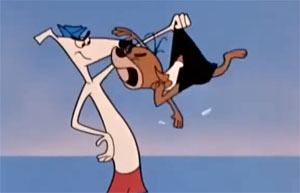 What more obvious place to look for a bathing beauty than at the beach, thinks Jeepers. Sure enough, there they find Cuddles under a beach umbrella. Jeepers fixes Creepers up in the T-shirt of a life guard, and pushes him over to introduce himself to the girl. Creepers’ efforts are greeted by a stare from Cuddles that solidifies in mid-air as a trail of ice (a gag lifted from the old Max Fleischer days, from Betty Boop’s “Red Hot Mamma” (1934)). The look is so intimidating, Creepers burrows into the sand, and tunnels his way back to Jeepers. Jeepers decides Creepers needs to look the part of a hero to draw her attention, so Jeepers pretends to be drowning just off shore. Creepers bravely dives off the pier, wearing a life preserver around his midriff. However, he forgets to untie the preserver from a cleat on the dock, and the life ring pops off, never making it with Creepers into the water. “Help! I can’t swim!”, sputters the helpless Creepers, while a disgusted Jeepers stands up, revealing the wayer is only three feet deep – all of this generating only laughter from Cuddles.
What more obvious place to look for a bathing beauty than at the beach, thinks Jeepers. Sure enough, there they find Cuddles under a beach umbrella. Jeepers fixes Creepers up in the T-shirt of a life guard, and pushes him over to introduce himself to the girl. Creepers’ efforts are greeted by a stare from Cuddles that solidifies in mid-air as a trail of ice (a gag lifted from the old Max Fleischer days, from Betty Boop’s “Red Hot Mamma” (1934)). The look is so intimidating, Creepers burrows into the sand, and tunnels his way back to Jeepers. Jeepers decides Creepers needs to look the part of a hero to draw her attention, so Jeepers pretends to be drowning just off shore. Creepers bravely dives off the pier, wearing a life preserver around his midriff. However, he forgets to untie the preserver from a cleat on the dock, and the life ring pops off, never making it with Creepers into the water. “Help! I can’t swim!”, sputters the helpless Creepers, while a disgusted Jeepers stands up, revealing the wayer is only three feet deep – all of this generating only laughter from Cuddles.
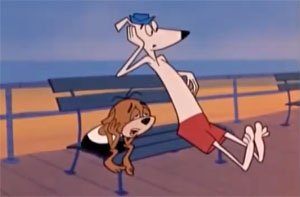 In a final sequence, Cuddles is observed engaging in friendly conversation with a cop on the beat. Jeepers presumes she’s attracted to anything in a uniform – so he fast-talks Creepers into joining the Marines. Creepers seems hardly Marine material, but Jeepers props up the floor under Creepers when he is being measured for height requirements, and, when a blood sample is requested, solves the problem of the empty veins of the anemic Creepers by filling the collecting receptacle with a bottle of red ink. Creepers passes his physical, and is inducted – only to discover Cuddles together with the cop again, wheeling a carriage with three pups in it – she’s already married. Creepers serves out his term stranded on a lonely remote island – but with Jeepers along for companionship and to mooch on the K-rations, brightening Creepers’ disposition by having him look at it as getting free accommodations (in a pup tent), three squares a day from tin cans, and a scenic view of nothing but nothing and water around them. Creepers happily, and gullibly, marches at his post, as the film fades out.
In a final sequence, Cuddles is observed engaging in friendly conversation with a cop on the beat. Jeepers presumes she’s attracted to anything in a uniform – so he fast-talks Creepers into joining the Marines. Creepers seems hardly Marine material, but Jeepers props up the floor under Creepers when he is being measured for height requirements, and, when a blood sample is requested, solves the problem of the empty veins of the anemic Creepers by filling the collecting receptacle with a bottle of red ink. Creepers passes his physical, and is inducted – only to discover Cuddles together with the cop again, wheeling a carriage with three pups in it – she’s already married. Creepers serves out his term stranded on a lonely remote island – but with Jeepers along for companionship and to mooch on the K-rations, brightening Creepers’ disposition by having him look at it as getting free accommodations (in a pup tent), three squares a day from tin cans, and a scenic view of nothing but nothing and water around them. Creepers happily, and gullibly, marches at his post, as the film fades out.
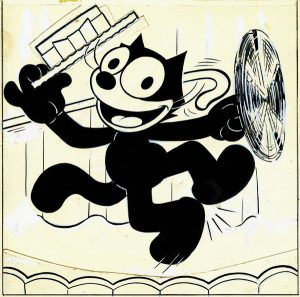 Production dates – and even correct working titles, are unavailable for Joe Oriolo’s television productions of Felix the Cat (1958-1961). I believe all the episodes discussed below are from the later batch of productions produced in 1960 and 1961. It is entirely unclear if Oriolo ever had an actual studio of his own, and even more unlikely that he took any actual personal hand in the productions. Instead, the nuts and bolts of these episodes appear to have been provided by the traditional suspects from Paramount/Famous studios, including sizeable animation from the pencil of Jim Tyer. Several of these included beach themes, including those discussed herein. (Episode titles may vary from source to source, actual titles never appearing on the films themselves.)
Production dates – and even correct working titles, are unavailable for Joe Oriolo’s television productions of Felix the Cat (1958-1961). I believe all the episodes discussed below are from the later batch of productions produced in 1960 and 1961. It is entirely unclear if Oriolo ever had an actual studio of his own, and even more unlikely that he took any actual personal hand in the productions. Instead, the nuts and bolts of these episodes appear to have been provided by the traditional suspects from Paramount/Famous studios, including sizeable animation from the pencil of Jim Tyer. Several of these included beach themes, including those discussed herein. (Episode titles may vary from source to source, actual titles never appearing on the films themselves.)
The Safe-Cracking Starfish finds Detective Felix taking a day off at the beach, when up from the depths of the ocean rise two familiar figures in skin diving gear – the Professor and Rock Bottom. The professor carries a goldfish bowl, inside of which is a bright pink starfish. Rock carries a large supply of oysters. (Good think the Walrus and the Carpenter aren’t nearby this time.) Suspicious Felix asks what sort of larceny the two are up to this time, but Rock innocently replies that they aren’t into larceny anymore, and have reformed. The Professor claims they are now engaged in marine life research. Felix congratulates them in their career move, stating, “It’s about time”, but has continued suspicions as the two head back to the laboratory, and decides to tag along for a little checking. At the lab, Professor and Rock check the pages of an oceanography text, with illustrations of how a starfish is allegedly the only marine life that can open oyster shells. The Professor runs an experiment, first having Rock try to pry a shell open – with no luck whatsoever. Then, the starfish is given a go at it. With two of its arms flexing like the muscles of a bodybuilder, the fish pries open the shell with sheer brute strength, consuming the prize within. Rock is wholeheartedly amazed, and Felix, watching through a window, acknowledges, “That’s research, all right.” But the Professor sees greater possibilities. “Such strength. He could open anything, if he were larger.”
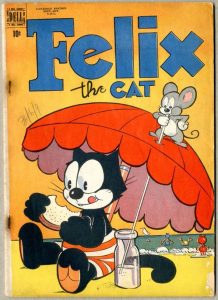 Then the brainstorm hits. “I’ll make him a giant!” Things in these low budgeted, minimally thought-out tales often happen quickly, usually without explanation. The Professor just happens to have at hand in the lab a large bottle of vitamin pills, believed to be perfect for the situation. Rock pours out most of the bottle into a tray of shucked oysters, and tells “Twinkle” (his nickname for the starfish) to come and get it. Simplifying animation, the starfish appears to swallow the oysters whole by pouring the whole tray down his throat. He instantly begins growing, until he is taller than Rock, and twice the beefcake. Again without explanation, Felix, who was already heading home convinced that the two former baddies were now legit, decides to go back to the window for one more look. He is in time to see Rock provide the massive starfish with a locked rented safe, and to watch the starfish rip the steel door off the safe entirely. Felix enters the room. “Safe crackers”, he accuses them, demanding that they surrender. “Says who?”, demands Rock. “Says this star” saud Felix, pointing to his detective badge. Rock counters this authority with his own “star” – namely, Twinkle, who grabs Felix in a headlock, then, upon Rock’s command, tosses Felix into another safe to be locked up tight. The Professor and Rock then spend the night having the starfish rip off the doors of bank vaults. Meanwhile, conveniently forgetful Felix receives a police bulletin about the robberies on a two way wrist radio he wears on his ankle – and entirely forgot that he could use to call out for help all the time. (Where’s that Mack truck to drive through the plot holes?) Felix radios the chief of police, who arrives with his men to release Felix from the safe. Felix then has the chief and his men hide inside the safe. Then, in the most convenient plot hole of all, Felix is suddenly in possession of a bottle of a “special sauce that’ll make that starfish normal again”! Was this the inscription on the label of a stray bottle in the Professor’s lab? If so, why did the Professor invent it, and when did Felix have the time to discover and read it? If not, is this the kind of item all detectives routinely carry in their crime prevention equipment? Even as a 6 year old kid, I remember reacting to this one with the thought, “What??” Felix hides, as the safecrackers return, and Twinkle is rewarded with another tray of oysters which Felix has spiked with the sauce. Twimkle shrinks back to normal. “Boss, we lost our safecracker!”, reacts a shocked Rock. “So what? We have plenty of money, and plenty of time”, responds the Professor. They’ll get plenty of time, as Felix appears, opening the safe door to reveal an arsenal of rifles pointed at the crooks from the cops inside. “Oh, what’s the use?” says Rock, as Felix closes with his usual laigh, and the disgusted starfish back in his goldfish bowl.
Then the brainstorm hits. “I’ll make him a giant!” Things in these low budgeted, minimally thought-out tales often happen quickly, usually without explanation. The Professor just happens to have at hand in the lab a large bottle of vitamin pills, believed to be perfect for the situation. Rock pours out most of the bottle into a tray of shucked oysters, and tells “Twinkle” (his nickname for the starfish) to come and get it. Simplifying animation, the starfish appears to swallow the oysters whole by pouring the whole tray down his throat. He instantly begins growing, until he is taller than Rock, and twice the beefcake. Again without explanation, Felix, who was already heading home convinced that the two former baddies were now legit, decides to go back to the window for one more look. He is in time to see Rock provide the massive starfish with a locked rented safe, and to watch the starfish rip the steel door off the safe entirely. Felix enters the room. “Safe crackers”, he accuses them, demanding that they surrender. “Says who?”, demands Rock. “Says this star” saud Felix, pointing to his detective badge. Rock counters this authority with his own “star” – namely, Twinkle, who grabs Felix in a headlock, then, upon Rock’s command, tosses Felix into another safe to be locked up tight. The Professor and Rock then spend the night having the starfish rip off the doors of bank vaults. Meanwhile, conveniently forgetful Felix receives a police bulletin about the robberies on a two way wrist radio he wears on his ankle – and entirely forgot that he could use to call out for help all the time. (Where’s that Mack truck to drive through the plot holes?) Felix radios the chief of police, who arrives with his men to release Felix from the safe. Felix then has the chief and his men hide inside the safe. Then, in the most convenient plot hole of all, Felix is suddenly in possession of a bottle of a “special sauce that’ll make that starfish normal again”! Was this the inscription on the label of a stray bottle in the Professor’s lab? If so, why did the Professor invent it, and when did Felix have the time to discover and read it? If not, is this the kind of item all detectives routinely carry in their crime prevention equipment? Even as a 6 year old kid, I remember reacting to this one with the thought, “What??” Felix hides, as the safecrackers return, and Twinkle is rewarded with another tray of oysters which Felix has spiked with the sauce. Twimkle shrinks back to normal. “Boss, we lost our safecracker!”, reacts a shocked Rock. “So what? We have plenty of money, and plenty of time”, responds the Professor. They’ll get plenty of time, as Felix appears, opening the safe door to reveal an arsenal of rifles pointed at the crooks from the cops inside. “Oh, what’s the use?” says Rock, as Felix closes with his usual laigh, and the disgusted starfish back in his goldfish bowl.
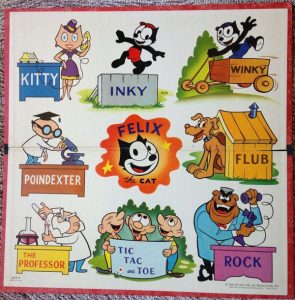 The Whale With the Gold Soul also places Felix on the beach, for another unusual marine life encounter. An old sea captain is spotted in a seaside diner by the disreputable Professor and Rock, who as usual are down on their luck and out of the money. The captain is paying his bill in shiny gold coins, making the Professor’s eyes bulge out. Unwanted company arrives in the form of Felix, causing Rock and the Professor to switch into comical disguises, as a goateed French painter and a golden curled little girl with an umbrella. They overhear conversation between Felix and the captain, where the captain asks a favor of Felix – take care of his pet whale while he is off on a voyage. The whale resides at Pirate’s Cove, and shows up if you play it music from a small music box. The big secret, however, is blabbed by the captain that the whale is the source of his gold – which she swallows out of sunken treasure ships, and delivers to the bearer of the music box, before taking a nap to the music. Felix agrees to the task, and is told he can have the gold the whale gives him. Not if the Professor and Rock can get there first, which they do by hiding underwater in the cove, breathing through reeds. (One of the more recognizable music cues from the Winston Sharples stock library gets reused here, lifted from the opening shots of “The Case of the Cockeyed Canary” (1952), still including a musical quote from the theme song, “Little Audrey Says”. Observant child I, I began to easily notice such things around my early teens.) Felix arrives with the box, and plays its tune across the water. Rising from the cove comes the whale, who swims right up to the shore, then opens its mouth, unrolling its tongue, upon which are several stacks of gold coins. Felix takes his fee, and the whale turns on its back and nods off to sleep. This tranquil scene is interrupted by the villains, who clamp Felix inside a giant clamshell and tie the shell shut with strands of dry seaweed. The villains try the music box trick, and receive a payoff from the whale as well, as she shuts her eyes for her second nap. But this method of payoff is a bit too slow, and the Professor wonders what can be done about it. Rock has an idea – why not go inside and get the gold personally, while the whale’s asleep? The Professor takes him up on this thought, and the two slip quietly into the whale’s mouth. Slip is right, as they have not counted upon the oily surfaces of the whale’s throat, and fall as if on a waterslide, directly into the whale’s tummy. Despite their predicament, Rock is thrilled to see the source of the gold – an entire swallowed pirate ship, loaded to the railings with coins. He lets out “three cheers for the treasure”, but awakens the whale. Spooked by the sounds within her, the whale takes frantically to the open sea, tossing the Professor and Rock about helplessly within her. Only Felix can solve this mess. Upon takeoff, a splash from the whale’s tail has dampened the seaweed forming the bindings around Felix’s shell. It makes the weed pliable enough to stretch, and Felix forces the shell open to free himself. The crooks have left behind the music box, and Felix uses it again to lure the whale and calm her from her panic. He tells the whale to release the villains, which she does by pumping them out through her blowhole. They land in a soggy piddle on the shore, visibly the worse for wear, as the Professor complains that something smells fishy. “Boss, we smell fishy”, observes Rock, and Felix takes the curtain line laugh again.
The Whale With the Gold Soul also places Felix on the beach, for another unusual marine life encounter. An old sea captain is spotted in a seaside diner by the disreputable Professor and Rock, who as usual are down on their luck and out of the money. The captain is paying his bill in shiny gold coins, making the Professor’s eyes bulge out. Unwanted company arrives in the form of Felix, causing Rock and the Professor to switch into comical disguises, as a goateed French painter and a golden curled little girl with an umbrella. They overhear conversation between Felix and the captain, where the captain asks a favor of Felix – take care of his pet whale while he is off on a voyage. The whale resides at Pirate’s Cove, and shows up if you play it music from a small music box. The big secret, however, is blabbed by the captain that the whale is the source of his gold – which she swallows out of sunken treasure ships, and delivers to the bearer of the music box, before taking a nap to the music. Felix agrees to the task, and is told he can have the gold the whale gives him. Not if the Professor and Rock can get there first, which they do by hiding underwater in the cove, breathing through reeds. (One of the more recognizable music cues from the Winston Sharples stock library gets reused here, lifted from the opening shots of “The Case of the Cockeyed Canary” (1952), still including a musical quote from the theme song, “Little Audrey Says”. Observant child I, I began to easily notice such things around my early teens.) Felix arrives with the box, and plays its tune across the water. Rising from the cove comes the whale, who swims right up to the shore, then opens its mouth, unrolling its tongue, upon which are several stacks of gold coins. Felix takes his fee, and the whale turns on its back and nods off to sleep. This tranquil scene is interrupted by the villains, who clamp Felix inside a giant clamshell and tie the shell shut with strands of dry seaweed. The villains try the music box trick, and receive a payoff from the whale as well, as she shuts her eyes for her second nap. But this method of payoff is a bit too slow, and the Professor wonders what can be done about it. Rock has an idea – why not go inside and get the gold personally, while the whale’s asleep? The Professor takes him up on this thought, and the two slip quietly into the whale’s mouth. Slip is right, as they have not counted upon the oily surfaces of the whale’s throat, and fall as if on a waterslide, directly into the whale’s tummy. Despite their predicament, Rock is thrilled to see the source of the gold – an entire swallowed pirate ship, loaded to the railings with coins. He lets out “three cheers for the treasure”, but awakens the whale. Spooked by the sounds within her, the whale takes frantically to the open sea, tossing the Professor and Rock about helplessly within her. Only Felix can solve this mess. Upon takeoff, a splash from the whale’s tail has dampened the seaweed forming the bindings around Felix’s shell. It makes the weed pliable enough to stretch, and Felix forces the shell open to free himself. The crooks have left behind the music box, and Felix uses it again to lure the whale and calm her from her panic. He tells the whale to release the villains, which she does by pumping them out through her blowhole. They land in a soggy piddle on the shore, visibly the worse for wear, as the Professor complains that something smells fishy. “Boss, we smell fishy”, observes Rock, and Felix takes the curtain line laugh again.
One of the better-paced, more tightly written episodes of the series is Super Relaxing Lawn Chair, a solo effort without the interference of the Professor and Rock. Felix resides in a house adjoining a beach shore and small pier overlooking a bay. He is awaiting the arrival of a package from the Miracle Super-Relaxing Lawn Chair company. The writers manage to build a whole episode out of the traditional folding beach chair gag origiating from “Toonerville Picnic” and refined in “Donald’s Vacation” discussed earlier in these articles, also reused in Little Audrey’s “Surf Bored” by Paramount. For once, the writers are creative enough to come up with some new twists – making me suspect the fine writing hand of Jack Mercer, who was providing the voice of Felix. When Felix’s package arrives, he takes the box to the shore to set up his new acquisition. The first thing to pop out of the box are the instructions – folded like a road map, with page after page of content, until Felix is waist deep in paper, as he trues to find page one to begin. Line one of the list reads, “First, open carton.” Felix does a double-take at the nonsensicality of this suggestion, as how else could he be reading this if he had not already passed this step, and asides to the audience, “A smart guy.” Felix reads on – “Then lift out chair, CAREFULLY.” “Okay, okay!”, comments Felix to the paper, already detecting that the author has an attitude problem. The chair’s rods, sticks, and canvas are definitely not ready for sitting straight out of the box, and Felix continues through instructions to pull crossbar A to engage rod B and release spring H – but do not trigger the automatic seat belt. “Seat belt? Does this thing fly?”, responds an increasingly perplexed Felix. Felix pulls on a rod – and the chair goes wild in flipping transformations, trapping him inside in the standard gag pose. He struggles to get loose, and the chair flips again, until he finds himself atop the canopy, precariously balanced vertically atop one of the pier pilings. His shock take triggers the chair again, which lands him back on the beach, under the contraption. Felix finds the instructions nearby, and searches for answers. The list continues, predicting Felix’s predicament with alarming accuracy. “Now try again, but be MORE CAREFUL. First, crawl out from under chair.” Felix is becoming constantly amazed, and nonplused, at this writer’s total command of the situation. The next entry is an illustration depicting a position for the user to assume atop the chair to accomplish the next rod maneuver. It already looks so ridiculously acrobatic, we can sense at a glance it can only lead to trouble. Felix pulls one bar down, but a second bar flips under his feet, causing Felix to be catapulted into the air. He lands draped over one portion of the canopy, and the other end of the canopy delivers multiple whacks to Felix’s rear end as if administering a spanking. Felix is finally flipped off the chair into the trunk of a tree. “That’s a dangerous chair”, shouts Felix, hiding behind the tree. “I wouldn’t touch it with a ten foot pole.” However, Felix is prepared. “Luckily, I have an eleven-foot pole.” He pokes at the chair with the end of it, but the canopy ends snap like wooden jaws, and bite the end of the pole clean off. “I’d better get this thing before it gets me”, says Felix, producing a lasso. He ropes the chair, and begins to haul it in, hoping to hogtie it. Instead, a yank on the rope pulls him out of frame, and Felix finds himself clamped between the ends of the canopy frame, caught in the device’s jaws, and precariously balanced at the edge of the pier, about to fall into the sea. “It got me”, observes the helpless cat.
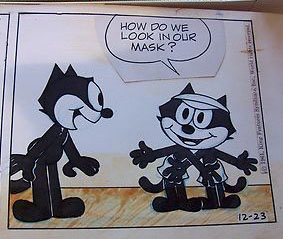 As part two of the episode begins, Felix is saved from falling in the bay by a passing seagull, who lands on the opposite end of the chair from Felix, redistributing the weight to tip the chair back onto the dock. Felix hears the telephone ring inside his home, and struggles once again to free himself. The chait goes into another flipping frenzy, and Felix finds himself back on dry land – but with the chair still clamped to his tail. The call turns out to be the Miracle Chair Company, following up on how their client likes the product. “It’ll be a “miracle” if I ever get it to work. I’m sending this chair right back. It’s a menace to life.” He hangs up the phone, and tries to pry the canopy off his tail. Once again, he is caught up in the chair’s wild contrortions, and somersaults with it outside and off the dock. Fortunately, it turns out the water around the pier is only three feet deep, and Felix rises to a standing position, free. The chair, however, remains partially submerged, with a few air bubbles escaping from under its canopy, then rests still. “Out like a light. Now’s my chance”, says Felix. He carefully lifts the chair out of the water without a fight, and slips it back into the box, then starts to carry the box back to the house. One stray pebble in the path provides all that is needed for Felix to slip, and the chair to be freed again. But by a stroke of sheer luck, the chair’s flipping somehow converts it into the proper working position. “It works! I knew I could do it!” But Felix remains cautious, and tries the pole test again. No bites this time. Finally convinced that the device is safe at last, Felix sets the chair adjacent to his backtard barbecue pit, and prepares himself a sizzling steak for lunch. As he settles down in the chair to carve at his entree, the top canopy of the chair begins to vibrate to life again, and the chair flips Felix off, and the steak atop the canopy roof. With another flip, the canopy tosses the steak into the sea. “I’ve had enough of this nonsense. You’re going swimming”, sayd Felix to the chair. The chair reacts in a cowering position, closing shut and holding onto its canopy as it trembles in fear. Felix makes good on his threat, and tosses the chair into the bay. Awhile later, Felix decides to enjoy his regained peace and quiet with a little fishing off the dock. He catches something – which of course turns out to be the chair again. But the chair has apparently learned its lesson, and wants to make amends, having netted in its canopy about a dozen fish – including one which holds his uneaten steak in its jaws. I guess the salt water provides a respectable marination, as Felix ends the cartoon on a happy note, relaxing in the chair, carving his reheated steak, while the fish sizzle on the grill for additional appetizers. The cartoon ends with a wink to the camera instead of the usual laugh.
As part two of the episode begins, Felix is saved from falling in the bay by a passing seagull, who lands on the opposite end of the chair from Felix, redistributing the weight to tip the chair back onto the dock. Felix hears the telephone ring inside his home, and struggles once again to free himself. The chait goes into another flipping frenzy, and Felix finds himself back on dry land – but with the chair still clamped to his tail. The call turns out to be the Miracle Chair Company, following up on how their client likes the product. “It’ll be a “miracle” if I ever get it to work. I’m sending this chair right back. It’s a menace to life.” He hangs up the phone, and tries to pry the canopy off his tail. Once again, he is caught up in the chair’s wild contrortions, and somersaults with it outside and off the dock. Fortunately, it turns out the water around the pier is only three feet deep, and Felix rises to a standing position, free. The chair, however, remains partially submerged, with a few air bubbles escaping from under its canopy, then rests still. “Out like a light. Now’s my chance”, says Felix. He carefully lifts the chair out of the water without a fight, and slips it back into the box, then starts to carry the box back to the house. One stray pebble in the path provides all that is needed for Felix to slip, and the chair to be freed again. But by a stroke of sheer luck, the chair’s flipping somehow converts it into the proper working position. “It works! I knew I could do it!” But Felix remains cautious, and tries the pole test again. No bites this time. Finally convinced that the device is safe at last, Felix sets the chair adjacent to his backtard barbecue pit, and prepares himself a sizzling steak for lunch. As he settles down in the chair to carve at his entree, the top canopy of the chair begins to vibrate to life again, and the chair flips Felix off, and the steak atop the canopy roof. With another flip, the canopy tosses the steak into the sea. “I’ve had enough of this nonsense. You’re going swimming”, sayd Felix to the chair. The chair reacts in a cowering position, closing shut and holding onto its canopy as it trembles in fear. Felix makes good on his threat, and tosses the chair into the bay. Awhile later, Felix decides to enjoy his regained peace and quiet with a little fishing off the dock. He catches something – which of course turns out to be the chair again. But the chair has apparently learned its lesson, and wants to make amends, having netted in its canopy about a dozen fish – including one which holds his uneaten steak in its jaws. I guess the salt water provides a respectable marination, as Felix ends the cartoon on a happy note, relaxing in the chair, carving his reheated steak, while the fish sizzle on the grill for additional appetizers. The cartoon ends with a wink to the camera instead of the usual laugh.
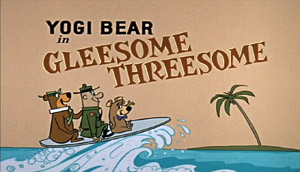 Gleesome Threesome (Hanna-Barbera, Yogi Bear, 2/13/61) – Honorable mention here, although the beach action is brief. Ranger Smith is planning his long-awaited two week vacation in Miami Beach. The main appeal of the excursion, mentioned by him three times more often than anything else, is “No Yogi Bear.” He calls up the hotel to make room reservations. Conveniently for this episode, he has developed a friendship outside of the park with a certain Charlie Behr and wife, for whom he books an adjoining room, claiming it “won’t be a vacation without them.” I know. You can see the setup coming a mile away. Yogi and Boo Boo eaves-drop, think the reservation is for them, and proceed to Miami. They are welcomed by the hotel staff, run by a Southern colonel, unquestioned, the Colonel thinking all Yankees look strange anyway. When Smith discovers the mix-up (causing him to pass out in a faint), he realizes the bears are government property, and that he’s responsible for them, so sterns himself to handle two weeks of baby-sitting the bears and putting up with their antics. On days when he claims he isn’t hungry, Yogi orders everything on the restaurant menu – twice. In the one sequence on the sand, the bears borrow the old gag from “Porky’s Naughty Nephew” and “Malibu Beach Party” of requesting to bury Ranger Smith in the sand. “Why fight it?”. the ranger moans, resigned to his fate. In rolls the inevitable dump truck, driven by Yogi, who states it’d have taken all day to do it the old fashioned way. Finally, the bears make the 6:00 news, together with an on-air thank you to the distraught Ranger Smith – which telecast gets seen by the Park Superintendent. But he is not angry, despite the bears’ absence from the park, as he states the publicity will do wonders for park attendance next season. He decides to send Yogi, Boo Boo, and the Ranger on an all expenses paid two month goodwill tour. “Two months with Yogi Bear!”, shouts the Ranger, and cracks, running off in hysterics. The Superintendent orders Yogi and Boo Boo to follow and bring him back. As the cartoon closes with the chase on between the bears and the ranger, Boo Boo asks if this means they’re already on tour now. Yodi states he believes so, “and this is doin’ it the hard way.”
Gleesome Threesome (Hanna-Barbera, Yogi Bear, 2/13/61) – Honorable mention here, although the beach action is brief. Ranger Smith is planning his long-awaited two week vacation in Miami Beach. The main appeal of the excursion, mentioned by him three times more often than anything else, is “No Yogi Bear.” He calls up the hotel to make room reservations. Conveniently for this episode, he has developed a friendship outside of the park with a certain Charlie Behr and wife, for whom he books an adjoining room, claiming it “won’t be a vacation without them.” I know. You can see the setup coming a mile away. Yogi and Boo Boo eaves-drop, think the reservation is for them, and proceed to Miami. They are welcomed by the hotel staff, run by a Southern colonel, unquestioned, the Colonel thinking all Yankees look strange anyway. When Smith discovers the mix-up (causing him to pass out in a faint), he realizes the bears are government property, and that he’s responsible for them, so sterns himself to handle two weeks of baby-sitting the bears and putting up with their antics. On days when he claims he isn’t hungry, Yogi orders everything on the restaurant menu – twice. In the one sequence on the sand, the bears borrow the old gag from “Porky’s Naughty Nephew” and “Malibu Beach Party” of requesting to bury Ranger Smith in the sand. “Why fight it?”. the ranger moans, resigned to his fate. In rolls the inevitable dump truck, driven by Yogi, who states it’d have taken all day to do it the old fashioned way. Finally, the bears make the 6:00 news, together with an on-air thank you to the distraught Ranger Smith – which telecast gets seen by the Park Superintendent. But he is not angry, despite the bears’ absence from the park, as he states the publicity will do wonders for park attendance next season. He decides to send Yogi, Boo Boo, and the Ranger on an all expenses paid two month goodwill tour. “Two months with Yogi Bear!”, shouts the Ranger, and cracks, running off in hysterics. The Superintendent orders Yogi and Boo Boo to follow and bring him back. As the cartoon closes with the chase on between the bears and the ranger, Boo Boo asks if this means they’re already on tour now. Yodi states he believes so, “and this is doin’ it the hard way.”
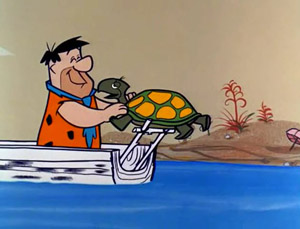 The Long, Long Weekend (Hanna-Barbera, The Flintstones, 3/10/61) – Fred runs across an advertisement for a seaside resort in the mail (the Gravel Hotel), run by an old chum Fred knew before he married Wilma, Gus Gravel, who he hasn’t heard from in years. Fred decides to ring him up on the phone and see if he can renew old acquaintances (as well as try to put the touch on him for special room rates for a three-day weekend). Meanwhile, Gus, known in the old days as “Smoothie” for his fast-talking, is still trying to resort to his gift of gab in a hotel labor dispute, but facing a losing battle, having lost the payroll payment on a bet on the 5th race. The staff walks out, with a convention booked for the weekend and no one to meet the customer needs. Gus receives the phone call, and has no immediate recognition or affinity for Fred – until dawn breaks with the recollection that Fred was a nice fat, gullible “pigeon”. Fred turns on the “old chum” sweet talk himself to finagle the low rates for both himself and the Rubbles. Gus goes him one better by offering to have the four of them down for the weekend free as his guests – all the while figuring that if his neighbors are as gullible as Fred is, he’s just found himself a substitute staff for the convention.
The Long, Long Weekend (Hanna-Barbera, The Flintstones, 3/10/61) – Fred runs across an advertisement for a seaside resort in the mail (the Gravel Hotel), run by an old chum Fred knew before he married Wilma, Gus Gravel, who he hasn’t heard from in years. Fred decides to ring him up on the phone and see if he can renew old acquaintances (as well as try to put the touch on him for special room rates for a three-day weekend). Meanwhile, Gus, known in the old days as “Smoothie” for his fast-talking, is still trying to resort to his gift of gab in a hotel labor dispute, but facing a losing battle, having lost the payroll payment on a bet on the 5th race. The staff walks out, with a convention booked for the weekend and no one to meet the customer needs. Gus receives the phone call, and has no immediate recognition or affinity for Fred – until dawn breaks with the recollection that Fred was a nice fat, gullible “pigeon”. Fred turns on the “old chum” sweet talk himself to finagle the low rates for both himself and the Rubbles. Gus goes him one better by offering to have the four of them down for the weekend free as his guests – all the while figuring that if his neighbors are as gullible as Fred is, he’s just found himself a substitute staff for the convention.
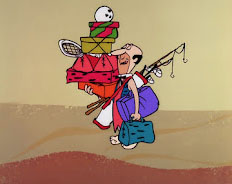 Fred, Barney, and the wives arrive. Gus rolls out the red carpet, and offers them the run of the place, encouraging them to go out onto the beach and spend the day on the sands. Wilma and Betty do just that, relaxing and sunbathing. Fred, however, is more of the active type, not wanting to let a minute go by without engaging in some vacation activity. “Last one in is a rotten dodo egg”, he shouts, charging for the surf in his swimming tiger suit. He reprises the old Goofy “Hawaiian Holiday” gag by missing the receding surf, bouncing headfirst upon submerged rocks, and having the tide return to wash over him. Barney revives hum with artificial respiration, and in three seconds Fred is ready and raring for more. He takes Barney fishing in a small rowboat, and Barney brings up the subject of sea serpents, which Fred dismisses as an old myth. Barney’s line hooks into something, and he tries to reel in. Up from under the boat rises the mammoth-sized head of an underwayer dinosaur (more of a huge brontosaurus type than an actual serpent). “I think I hust caught an old myth”, Barney mutters, then asks Fred what he should do. “Throw hum back”, yells Fred. But it is too late, as the boat slides down the dinosaur’s back, and soars off the end of his tail, straight into the window of one of the hotel suites, frightening a female guest into hysterics. Gus takes her frantic call at the front desk, and in disbelief, says he’ll take care of the two men in her room, but that she’ll have to take care of the rowboat herself. Still undaunted, Fred takes Barney for some scuba diving (probably assuming the sea monsters won’t invade shallow water). Swimming with snorkels, the boys don’t expect the arrival of a tired dodo bitd, who perches first on Fred’s snorkel. Fred blows hard, blasting all the feathers off the bird. It merely moves a step over to Barney’s snorkel, and Barney goes down for the count from lack of air. Now it’s Fred who has to administer the artificail respiration.
Fred, Barney, and the wives arrive. Gus rolls out the red carpet, and offers them the run of the place, encouraging them to go out onto the beach and spend the day on the sands. Wilma and Betty do just that, relaxing and sunbathing. Fred, however, is more of the active type, not wanting to let a minute go by without engaging in some vacation activity. “Last one in is a rotten dodo egg”, he shouts, charging for the surf in his swimming tiger suit. He reprises the old Goofy “Hawaiian Holiday” gag by missing the receding surf, bouncing headfirst upon submerged rocks, and having the tide return to wash over him. Barney revives hum with artificial respiration, and in three seconds Fred is ready and raring for more. He takes Barney fishing in a small rowboat, and Barney brings up the subject of sea serpents, which Fred dismisses as an old myth. Barney’s line hooks into something, and he tries to reel in. Up from under the boat rises the mammoth-sized head of an underwayer dinosaur (more of a huge brontosaurus type than an actual serpent). “I think I hust caught an old myth”, Barney mutters, then asks Fred what he should do. “Throw hum back”, yells Fred. But it is too late, as the boat slides down the dinosaur’s back, and soars off the end of his tail, straight into the window of one of the hotel suites, frightening a female guest into hysterics. Gus takes her frantic call at the front desk, and in disbelief, says he’ll take care of the two men in her room, but that she’ll have to take care of the rowboat herself. Still undaunted, Fred takes Barney for some scuba diving (probably assuming the sea monsters won’t invade shallow water). Swimming with snorkels, the boys don’t expect the arrival of a tired dodo bitd, who perches first on Fred’s snorkel. Fred blows hard, blasting all the feathers off the bird. It merely moves a step over to Barney’s snorkel, and Barney goes down for the count from lack of air. Now it’s Fred who has to administer the artificail respiration.
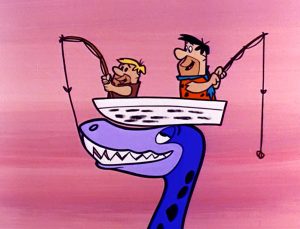 Finally exhausted, the four return to the hotel, in time for Gus to put on his act. With hopelessness in his eyes, he breaks the news as if the staff has just quit. He brings up the old gang, and how no one has the “pitch-in” spirit to help out a friend anymore. Fred stands up for the honor of the old group, and, emphasizing to Barney and the wives how Gus took them in out of the goodness of his heart and now faces an hour of need, makes the three of them feel like first class heels for their first instincts to immediately leave the hotel. Fred thus volunteers their services to Gus to help out in any way (expecting that Gus will actually be too big-hearted to accept). Instead, Gus eagerly throws upon the four, chef’s, bellboy’s, and maids’ hats, and encourages them to get busy, busy, busy. The wives smell a rat, and while they labor with the housework they intended to get away from, spot busloads of guests arriving for the convention of the Loyal Order of Water Buffalos. (This episode marks a landmark in the series for the first use of the organization that would become Fred and Barney’s favorite nighttime destination besides the bowling alley, though the boys are not yet members.) The girls break the news to the boys, finding Barney sweating under the weight of the luggage of the arriving mob, and Fred trying to figure out how to “fold in” a dodo egg into a batter. (“I say it can’t be done”, he says, with egg splashed on his face.) The four turn in their resignations, and Gus faces the music in the presence of the exalted Grand Poobah of the lodge. But the Poobah thinks the emergency is well in hand, as the lodge’s ladies’ auxiliary is in attendance. The Poobah issues an edict for the ladies to pitch in and take over the staff tasks to save the convention. His suggestion starts a riot among the wives, who insist he’s out of his mind. The Poobah flees for his life, and to save his neck, passes his hat to Fred, declaring him the new Poobah (a title I believe Fred would never again hold in the series). Now Fred runs for his life, taking Barney and the girls with him. As they all drive away, Wilma grabs Fred’s new hat, and issues an official edict of her own – take them to a hotel where they can have a real vacation for the remainder of the weekend. The boys humbly bow and obey, Barney adding, “If we know what’s good for us.”
Finally exhausted, the four return to the hotel, in time for Gus to put on his act. With hopelessness in his eyes, he breaks the news as if the staff has just quit. He brings up the old gang, and how no one has the “pitch-in” spirit to help out a friend anymore. Fred stands up for the honor of the old group, and, emphasizing to Barney and the wives how Gus took them in out of the goodness of his heart and now faces an hour of need, makes the three of them feel like first class heels for their first instincts to immediately leave the hotel. Fred thus volunteers their services to Gus to help out in any way (expecting that Gus will actually be too big-hearted to accept). Instead, Gus eagerly throws upon the four, chef’s, bellboy’s, and maids’ hats, and encourages them to get busy, busy, busy. The wives smell a rat, and while they labor with the housework they intended to get away from, spot busloads of guests arriving for the convention of the Loyal Order of Water Buffalos. (This episode marks a landmark in the series for the first use of the organization that would become Fred and Barney’s favorite nighttime destination besides the bowling alley, though the boys are not yet members.) The girls break the news to the boys, finding Barney sweating under the weight of the luggage of the arriving mob, and Fred trying to figure out how to “fold in” a dodo egg into a batter. (“I say it can’t be done”, he says, with egg splashed on his face.) The four turn in their resignations, and Gus faces the music in the presence of the exalted Grand Poobah of the lodge. But the Poobah thinks the emergency is well in hand, as the lodge’s ladies’ auxiliary is in attendance. The Poobah issues an edict for the ladies to pitch in and take over the staff tasks to save the convention. His suggestion starts a riot among the wives, who insist he’s out of his mind. The Poobah flees for his life, and to save his neck, passes his hat to Fred, declaring him the new Poobah (a title I believe Fred would never again hold in the series). Now Fred runs for his life, taking Barney and the girls with him. As they all drive away, Wilma grabs Fred’s new hat, and issues an official edict of her own – take them to a hotel where they can have a real vacation for the remainder of the weekend. The boys humbly bow and obey, Barney adding, “If we know what’s good for us.”
Watch this episode HERE.
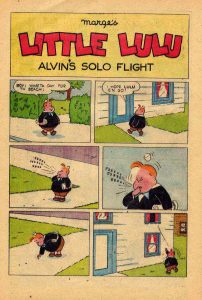 Alvin’s Solo Flight (Paramount. Comic Kings. Little Lulu, 4/61 (exact release date unknown) – Seymour Kneitel, dir.). After about a fourteen year hiatus, and the executive move that had caused Paramount to break from its relationship with character creator Marge in favor of substituting the studio’s own “Little” Audrey in place of the Saturday Evening Post character to save on royalties, Paramount curiously returned to an experiment to revive the Little Lulu series, re-teaming with Marge for two episodes, each with little success. Paramount was of course by this time in a bind to find new characters to replace the ones whose rights had been sold off (Audrey included), as discussed above. The thought that rights to the successful Lulu series might be re-acquired was something of a brainstorm – but the zing of the old series had somehow vanished, both in its writing style (which seems for these two episodes to now depend entirely upon adaptation of comic book stories, which had taken much of the edge off the character from her Saturday Evening Post days in favor of gentler storylines), and in its execution, now having to settle for the substantially more limited animation of reduced 1960’s Paramount budgets. The results were a bit lackluster, and develop at most smiles rather than real laughs. To their credit, however, the voicings are fresh, and have a bit of the feeling of the soundtrack of a Peanuts special. A curious sidelight is also the copyright indicia on these films, with Marge, as a part of her new deal with Paramount, retaining copyright to the two titles in her own name instead of the studio’s. Likely for this reason, the two fims are not known to have received television distribution in any package, and probably remain to this day outside of Paramount’s formal holdings for syndication.
Alvin’s Solo Flight (Paramount. Comic Kings. Little Lulu, 4/61 (exact release date unknown) – Seymour Kneitel, dir.). After about a fourteen year hiatus, and the executive move that had caused Paramount to break from its relationship with character creator Marge in favor of substituting the studio’s own “Little” Audrey in place of the Saturday Evening Post character to save on royalties, Paramount curiously returned to an experiment to revive the Little Lulu series, re-teaming with Marge for two episodes, each with little success. Paramount was of course by this time in a bind to find new characters to replace the ones whose rights had been sold off (Audrey included), as discussed above. The thought that rights to the successful Lulu series might be re-acquired was something of a brainstorm – but the zing of the old series had somehow vanished, both in its writing style (which seems for these two episodes to now depend entirely upon adaptation of comic book stories, which had taken much of the edge off the character from her Saturday Evening Post days in favor of gentler storylines), and in its execution, now having to settle for the substantially more limited animation of reduced 1960’s Paramount budgets. The results were a bit lackluster, and develop at most smiles rather than real laughs. To their credit, however, the voicings are fresh, and have a bit of the feeling of the soundtrack of a Peanuts special. A curious sidelight is also the copyright indicia on these films, with Marge, as a part of her new deal with Paramount, retaining copyright to the two titles in her own name instead of the studio’s. Likely for this reason, the two fims are not known to have received television distribution in any package, and probably remain to this day outside of Paramount’s formal holdings for syndication.
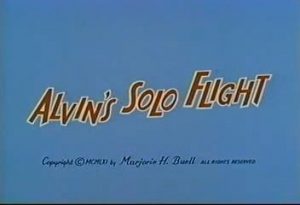 Tubby arrives at the Moppet residence to take Lulu to the beach. Mrs. Moppet, however, reminds Lulu that she promised to baby sit Alvin today – a toddler known to be something of a pest. Tubby figures this is his cue to go to the beach alone, but Lulu suggests they take Alvin along. Tubby is resistant, until he hears that Lulu will be paid in advance her babysitting rate of fifty cents – making Lulu a valuable friend to have along for the day.
Tubby arrives at the Moppet residence to take Lulu to the beach. Mrs. Moppet, however, reminds Lulu that she promised to baby sit Alvin today – a toddler known to be something of a pest. Tubby figures this is his cue to go to the beach alone, but Lulu suggests they take Alvin along. Tubby is resistant, until he hears that Lulu will be paid in advance her babysitting rate of fifty cents – making Lulu a valuable friend to have along for the day.
Alvin (depicted now as about three or four years old, as opposed to his only previous appearance in “The Baby Sitter”, where he was still in a crib), is his usual problem self, constantly complaining “I’m hungry.” To distract him, Lulu suggests he try to cover Tubby in sand (Tubby daring Alvin that he probably can’t do it, given Tubby’s size). Alvin begins the task, but is still grumpy, and reaches a point of frustration where he bites one of Tubby’s toes to appease his appetite. Tubbt calls him a little cannibal, but Lulu decides it’s best to get him a hot dog from the boardwalk. She hands Tubby 20 cents – enough for only one hot dog. Tubby complains, what about him, sure that Alvin won’t share. Sure enough, when Lulu asks Alvin if he’ll let Tubby have a bite, Alvin responds with a resounding “No!”. So Lulu proposes that Tubby take a bite before ganding the hot dog to Alvin, ensuring his share. Tubby adds to the insurance at the hot dog stand, asking for sauerkraut and mustard, even though Alvin has made verbally plain that he doesn’t like sauerhraut and mustard. Tubby partakes of a neat one-half of the dog, then bends down to hand the rest to Alvin. But Alvin has disappeared without a trace.
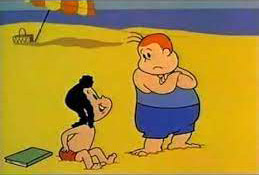 Tubby reports the disappearance to Lulu (after downing the other half of the hot dog, not to let it go to waste), who suggests looking for Alvin at the beach’s lost children station. The guard in charge escorts them over to a large shed, lets them in, and says, “I’ll show you what we have in stock. The entire room is encircled with a perimeter of wailing toddlers sitting on benches. None of them are Alvin, though one resembles him a little if seen from the back. And the two babysitters seriously consider bringing home a substitute in hopes Mom won’t notice, and on the thought that the change might be an improvement over what she’s got. The two spend the next several hours combing up and down the beach and boardwalk, with no sign of Alvin. What they have missed is that Alvin has wandered over to a balloon vendor, whose wares are tied to a fence railing. The vendor is blowing up a long sausage-like balloon. Hungry Alvin decides to take a bite on the other end, popping the balloon and blasting the vendor over the fence railing. With no one standing guard, Alvin runs over to the remaining balloons and unties them. Their helium carries him aloft, sailing him over the coastline, then back over the mainland and the city. As dusk is oncoming, Lulu and Tubby return home on a bus, empty-handed, and wondering what to say to Alvin’s Mom. When they near the house, Tubby declares he’s not going anywhere near the place, and Lulu resigns herself to facing the music alone. Jist before reaching the door, they hear a wail from the limbs of a nearby tree. “Alvin, is that you?” calls out Lulu. “No”, comes an obstinate reply – but the voice is unmistakably Alvin’s. Tubby climbs the tree, and retrieves the youth. But Alvin is too young to know how to climb trees, so they attempt to solve the mystery of Alvin’s reappearance. “I flew”, Alvin repeatedly insists, without further elaboration. Not only that, he wants to do it again. Lulu gives up trying to figure the kid’s ridiculous story out, and returns Alvin to his mother, hoping Mom won’t be angry at returning him so late. To her surprise, she receives as extra fifty cents for keeping Alvin out of Mom’s hair longer than expected. Tubby closes the film with the observation that she’d probably have gotten a bigger bonus if they had actually brought home one of those other kids from the lost children station.
Tubby reports the disappearance to Lulu (after downing the other half of the hot dog, not to let it go to waste), who suggests looking for Alvin at the beach’s lost children station. The guard in charge escorts them over to a large shed, lets them in, and says, “I’ll show you what we have in stock. The entire room is encircled with a perimeter of wailing toddlers sitting on benches. None of them are Alvin, though one resembles him a little if seen from the back. And the two babysitters seriously consider bringing home a substitute in hopes Mom won’t notice, and on the thought that the change might be an improvement over what she’s got. The two spend the next several hours combing up and down the beach and boardwalk, with no sign of Alvin. What they have missed is that Alvin has wandered over to a balloon vendor, whose wares are tied to a fence railing. The vendor is blowing up a long sausage-like balloon. Hungry Alvin decides to take a bite on the other end, popping the balloon and blasting the vendor over the fence railing. With no one standing guard, Alvin runs over to the remaining balloons and unties them. Their helium carries him aloft, sailing him over the coastline, then back over the mainland and the city. As dusk is oncoming, Lulu and Tubby return home on a bus, empty-handed, and wondering what to say to Alvin’s Mom. When they near the house, Tubby declares he’s not going anywhere near the place, and Lulu resigns herself to facing the music alone. Jist before reaching the door, they hear a wail from the limbs of a nearby tree. “Alvin, is that you?” calls out Lulu. “No”, comes an obstinate reply – but the voice is unmistakably Alvin’s. Tubby climbs the tree, and retrieves the youth. But Alvin is too young to know how to climb trees, so they attempt to solve the mystery of Alvin’s reappearance. “I flew”, Alvin repeatedly insists, without further elaboration. Not only that, he wants to do it again. Lulu gives up trying to figure the kid’s ridiculous story out, and returns Alvin to his mother, hoping Mom won’t be angry at returning him so late. To her surprise, she receives as extra fifty cents for keeping Alvin out of Mom’s hair longer than expected. Tubby closes the film with the observation that she’d probably have gotten a bigger bonus if they had actually brought home one of those other kids from the lost children station.
More 60’s, more sun, next week.


 Charles Gardner is an animation enthusiast who toils by day as a member of LA Law – but by nights and weekends indulges in classic jazz and ragtime as a performer; and studies classic Hollywood cartoons… maybe a little too much.
Charles Gardner is an animation enthusiast who toils by day as a member of LA Law – but by nights and weekends indulges in classic jazz and ragtime as a performer; and studies classic Hollywood cartoons… maybe a little too much.


































































































































































There were a few episodes of Felix the Cat that really scared me when I was little. “Stone Age Felix” was one of them, chiefly because of the mammoth that menaces him just before he returns to the present day. “Super Relaxing Lawn Chair” was another. The idea of a lawn chair that could bite the end off an 11-foot pole was so terrifying to my young mind that I was afraid to sit on our own reclining lawn chair in the backyard. Which was just fine with my mother.
And, when it comes to giant starfish-sized plot holes, what about “Gleesome Threesome”? Glossing over the matter of how Yogi and Boo Boo managed to get to Miami Beach before Ranger Smith arrived there, we’re left with the question of what happened to Ranger Smith’s friends Charlie and Carolyn Behr. I mean, they’re such good friends that they always vacation together, Smith offered to put them up at the hotel at his own expense, and then they just don’t show up??? It would have been better if they had, and thought that Smith had brought a couple of fun-loving bears from Jellystone Park along with him as a wonderful surprise. If the Behrs and the bears hit it off and made Smith feel like a fifth wheel, that would compound his misery and make his tribulations all the funnier. Oh well, too late to do anything about it now.
The weirdest thing about “Alvin’s Solo Flight” is that Little Lulu is apparently wearing a boy’s bathing suit. I understand that she’s too young to require anything in the way of a support garment, but the fact is, she’s a girl going topless at the beach (while Tubby, meanwhile, is wearing a singlet). Some of the little girls in the Lost Children Station are topless as well. I don’t recall girls doing this in the ’60s; I know my sister and her friends never did. If the cartoon hadn’t been kept out of television syndication for copyright reasons, sooner or later it probably would have been denounced as child pornography by the family values crowd.
Looking forward to seeing the Flintstones return to the beach for a “Surfin’ Craze”. “Last one in is a hodad!”
Charlie Chaplin grappled with a deck chair in “A Day’s Pleasure” (1919), where it was actually on a deck. He may have been the first on film, but no bets beyond that.
And by the way — Happy birthday, Charles!
A recent article in Hogan’s Alley, the online magazine of the cartoon arts (“Marge and Lulu: The Art of the Deal” by Jennifer Gotwals, 22 May 2021), sheds some light on the business deals that gave rise to the two Little Lulu cartoons of the early 1960s, “Alvin’s Solo Flight” and “Frog’s Legs”. Both cartoons give co-producer credit to cartoonist Marjorie H. Buell and William C. Erskine, her licensing agent from 1943 to 1972. Marge’s first contract with Paramount was signed just before she entered into partnership with Erskine, and under its terms she received a flat $500 for each cartoon made, plus 5 percent of all profits above that sum — a guaranteed return on a venture that required no artistic work on her part.
After Erskine brokered a television syndication deal for the original Little Lulu cartoons in the late 1950s, he began negotiating with Paramount to create a series of new cartoons for TV titled “Little Lulu’s Playhouse”. By this time, however, the character’s popularity had declined to the point that Erskine and Marge had to accept a contract on much less favourable terms. The new contract demanded that they each put up $3500 toward the projected $14,000 budget of a Little Lulu cartoon, which would be released theatrically and then serve as the pilot episode of the TV series. Once Paramount recouped its $7000 investment in the cartoon, they would keep 40 percent of all profits with the remaining 60 percent to be split between Marge and Erskine. Beyond that, they would split a meagre 5 percent of profits on each television episode and receive a flat $1000 for the use of the pilot film.
As it happened, only two cartoons were produced, and no TV series eventuated. Between 1961 and 1971, when she sold the rights to Little Lulu to Western Publishing, Marge made exactly $2,376.79 from “Alvin’s Solo Flight”. In other words, she lost over a thousand dollars on it. The experience soured her working relationship with Erskine and led to her decision to divest herself of the rights to the franchise.